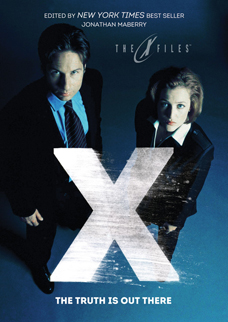“The Truth is Out There,” the February follow-up to last year’s “Trust No One,” serves up another mixed bag of “X-Files” short stories that’s on par with the first collection. It’s not “The X-Files” at its finest, but it’s a fun assortment that will tide fans over between comic installments.
The biggest improvement in Volume 2 is in the line editing; there are probably 90 percent fewer typos and grammatical errors. However, the continuity problems are more prevalent. This book is from comic publisher IDW, and it says so prominently on the spine, but an introductory note explaining that these stories are part of the IDW comics continuity would have helped.
(The comics continuity and TV continuity branch off in 2013. In the comics continuity, Mulder and Scully rejoin the X-Files, they are still a happy couple and the Lone Gunmen are revealed to be alive. In the TV continuity, M&S rejoin the X-Files in 2016, they are separated and the Gunmen have not been revealed to be alive. Further confusing matters, a comic series based on the TV continuity launches this month.)
At least one continuity mistake is completely inexcusable: In Hank Schwaeble’s “Male Privilege,” the agents investigate an X-File in 2006, which is during the period when they were not only off the X-Files, but also the X-Files were closed and M&S were keeping their distance from the FBI as much as possible.
Still, there are some fun ideas explored among these 15 short stories. Here are my picks for the 10 best:
1. “Black Hole Son” by Kami Garcia (1977, Massachusetts) – The short-story anthologies (and comics, for that matter) need to produce more stories like this one, which tells of a teenage Fox Mulder digging into his sister’s disappearance. The surprising highlight is his crush on his best friend, Phoebe (not to be confused with Phoebe Green from Season 1’s “Fire,” although it does show that Mulder has a thing for girls named Phoebe).
2. “XXX” by Glenn Greenberg (1999, California) – Especially toward the later seasons, “The X-Files” began to find a layer of winky humor amid serious stories of bizarre and gruesome deaths. Remarkably, the show never really went all-in with an episode having fun with Mulder’s porn addiction, but Greenberg makes up for it here as M&S investigate a case involving Mulder’s favorite adult-film actress.
3. “Heart” by Kendare Blake (1995, New Jersey) – The Topps comics briefly touched on the idea of strange connections between organ donors and their recipients in Issue 23, “Donor.” This yarn is a meatier character piece as we get into the head of a quiet old man named Arthur who gradually takes on the decidedly different traits of the murder victim from whom he received a heart.
4. “Mummiya” by Greg Cox (1996, Washington) – Cox, the author of some “Terminator” novels, tells an effectively creepy tale about a terminal patient who attempts to mummify and resurrect herself via ancient magic – somewhat in the vein of Season 4’s “Kaddish” — with a nice twist at the end.

5. “Voice of Experience” by Rachel Caine (1993, Washington, D.C.) – This story features a villain who mesmerizes people and drains their emotions by making eye contact with them, which is the perfect type of character for the written word rather than for TV. The way Mulder finds clues through the villain’s work as a professional novelist is also a fun concept.
6. “Dead Ringer” by Kelly Armstrong (1993, Pennsylvania) – Mulder and Scully discover corpses that are genetic matches to people who are still alive, something that feels like a vintage X-File. The concept of faeries deviates a bit from the premise, as “The X-Files” doesn’t delve into mystical creatures too often. But the idea of beings who take over the lives of murder victims to help the families is intriguingly bittersweet.
7. “Snowman” by Sarah Stegall (2001, Washington) – Agent Doggett is usually ignored in IDW’s work, so Stegall gets bonus points for featuring him. As Mulder joins the adventure, this ends up being a decent exploration of both the Abominable Snowman legend and a scary military experiment. The only misfire is that Stegall makes Doggett too much of a skeptic, as he had already experienced a season’s worth of X-Files as Scully’s partner at this point.
8. “Drive Time” by John McGoran (2016, Massachusetts) – McGoran delivers a mind-bending time-travel story that calls to mind Season 4’s similarly weird-science-based “Synchrony.” The yarn would also sit well in the “Terminator” universe, particularly the over-the-top conclusion where multiple versions of the time traveler wink out of existence every time an older version of the time traveler is killed.
9. “We Should Listen to Some Shostakovich” by Hank Phillippi Ryan (2017, Washington, D.C.) – The mystery centered on clues hidden in a series of paintings doesn’t play as well with the written word as it would visually, but this is a remarkable entry for another reason: It’s chronologically the last story in the IDW comics timeline, and it provides some major details. Scully’s mom (who died in the TV miniseries) is still alive and well, M&S move into a new house, and they have another baby, named Allie.
10. “Pilot” by David Liss (1996, Washington, D.C.) – Liss gets meta with “The X-Files” as M&S are introduced to an alternate universe where they aren’t real people, but rather characters on a TV show. It doesn’t work as well as, say, Season 7’s “Hollywood A.D.” – where the agents’ lives are portrayed in a show-within-the-show – but it’s still an entertaining attempt.

